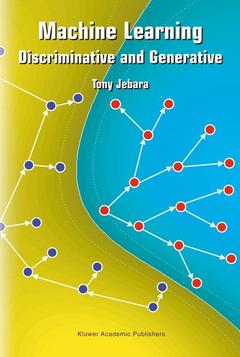Description
Machine Learning, 2004
Discriminative and Generative
The Springer International Series in Engineering and Computer Science Series, Vol. 755
Author: Jebara Tony
Language: English
Subjects for Machine Learning:
Keywords
Approximative price 105.49 €
In Print (Delivery period: 15 days).
Add to cartPublication date: 09-2012
200 p. · 15.5x23.5 cm · Paperback
Approximative price 105.49 €
Subject to availability at the publisher.
Add to cartPublication date: 12-2003
200 p. · 15.5x23.5 cm · Hardback
Description
/li>Contents
/li>Comment
/li>
Machine Learning:Discriminative and Generative covers the main contemporary themes and tools in machine learning ranging from Bayesian probabilistic models to discriminative support-vector machines. However, unlike previous books that only discuss these rather different approaches in isolation, it bridges the two schools of thought together within a common framework, elegantly connecting their various theories and making one common big-picture. Also, this bridge brings forth new hybrid discriminative-generative tools that combine the strengths of both camps. This book serves multiple purposes as well. The framework acts as a scientific breakthrough, fusing the areas of generative and discriminative learning and will be of interest to many researchers. However, as a conceptual breakthrough, this common framework unifies many previously unrelated tools and techniques and makes them understandable to a larger portion of the public. This gives the more practical-minded engineer, student and the industrial public an easy-access and more sensible road map into the world of machine learning.
Machine Learning: Discriminative and Generative is designed for an audience composed of researchers & practitioners in industry and academia. The book is also suitable as a secondary text for graduate-level students in computer science and engineering.



